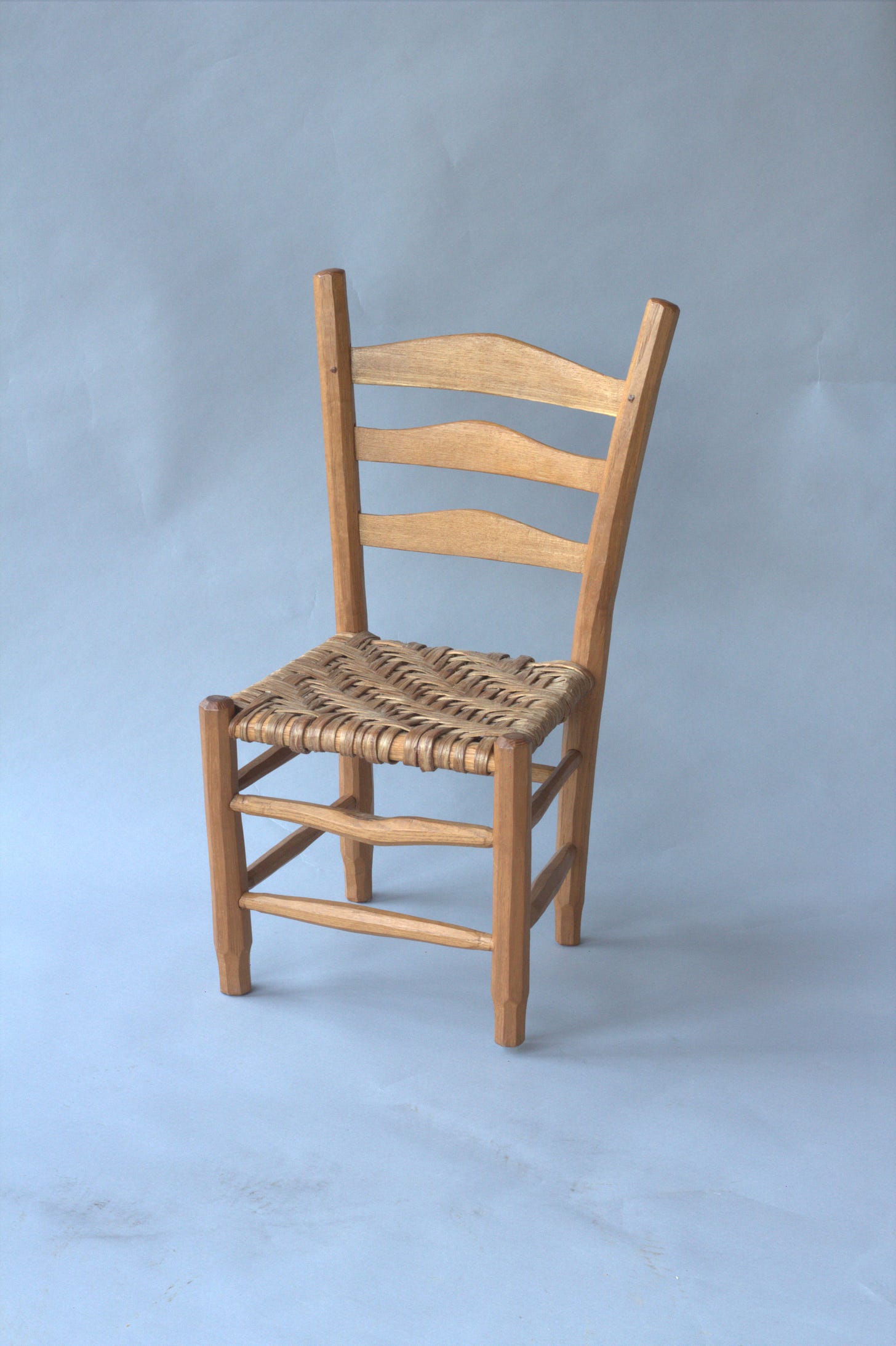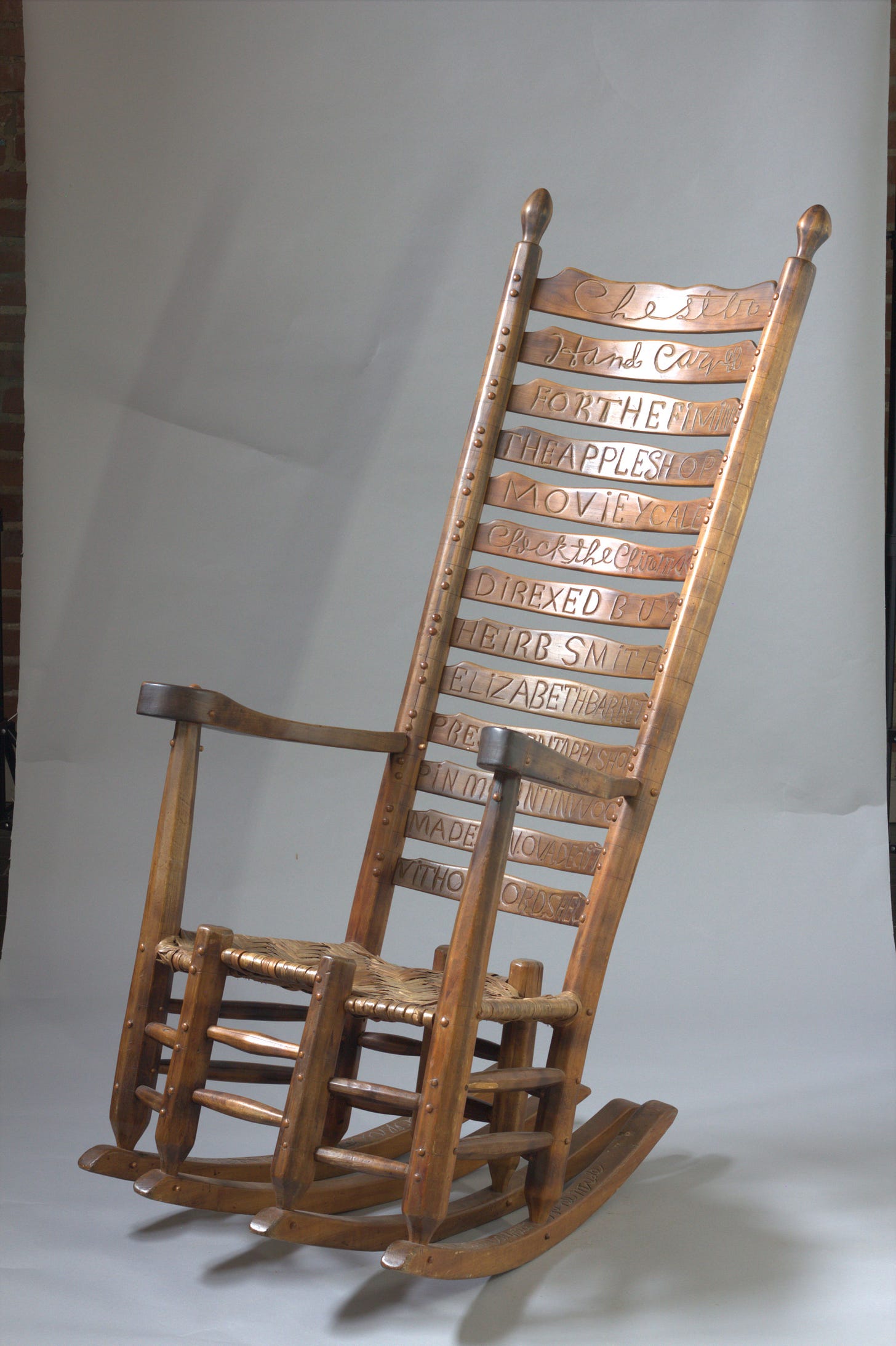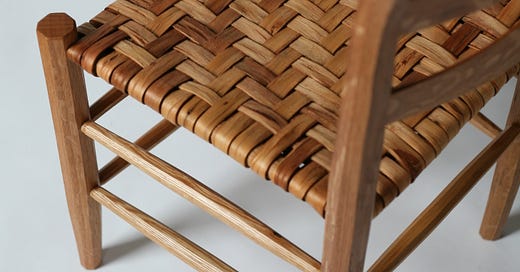I am spending this morning with the chairmaker’s gathering in mind. We are only two weeks out at this point, and excitement (part panic?!?) has me working through the details. There are still a couple of tickets remaining if you’d like to join us in Berea, Kentucky on June 2nd. The main is around the chairmakers I visited and profiled in Backwoods Chairmakers.

I’m working to put each chairmaker in their ideal spot - either behind the microphone, in presentation and storytelling, or at the shave horse at work and in private conversation with the visitors. It has me thinking of my travels and visits with these makers at their home shops. And considering the various ways they go about making their chairs.
It’s this variety, and the success each maker found in their own methods, that makes this field so interesting. There is no “right” way….no single method or required approach. No “chairmaking test kitchen” to declare the proper way to put together a chair. The results are found in decades of successful chairs, each standing after the rigors of daily use.
Putting the variety of design aside (and obvious), I found the construction variation most intriguing. All the chairmakers required quality, strong materials. All followed the traditional green woodworking methods, with posts of higher moisture content and rungs dried to a full extent. Those are the similarities, and that’s where things start getting interesting.
Those makers who shaved their chairs used the wettest/freshest materials available. The moisture allows for easier work with hand tools. Rungs are dried under tin roofs, above the wood stove, and with the aid of the summer sun.
Chairmakers who turn do not want wet wood. It turns poorly at the lathe…..fuzzing up, lacking crisp detailing, and distorting heavily as it dries. Those who turn prize dried materials for their posts…..usually air dried, often cut by the chairmaker. That material is frequently cut and given a year or two before working into a chair. It still has moisture in it, and it works nicely at the lathe.
Only one chairmaker used a moisture meter. He meticulously dries his materials, going to 8% for posts and 4% for rungs, so his chairs still receive the greenwood moisture differential while minimizing distortion on his contemporary designs. His approach focuses on the ideal glue bond. His approach was unique, one that came out of traditional greenwood chairmaking and is the foundation to his current work.
The other chairmakers remain firmly in the traditions of the past. Most use glue in their chairs, but not all. Posts hold moisture and the rungs dried. The chairmakers of Cannon County, TN, purchase their rungs (I recall heaps hickory dowels). Some rungs are dried in rafters, others in out buildings or even a converted tractor trailer made into a kiln. The dried dowels have tenons cut onto them before assembly. One chairmaker converted a washing machine motor into a tenon cutter. Another had a rig set up on the lathe to cut the tenon while adding a awl prick to the center of the blank. He added the tenon to a square stock of wood first, then chucked it into a lathe to turn it’s shape.
My training was through the furniture making program at the North Bennet Street School. One of the many things I internalized was the “right” way to do things. The instructors would debate construction methods, design details, and the proper process. It was incredible to watch - talented, experienced furniture makers arguing and debating the “best” way to go about a given project. They frequently cited written resources and photos of documented furniture to support their arguments. It was an awesome sight watching my mentors debate case construction and building process.
At the root was the notion that there is a proper way to go about any piece. An absolute way that provides integrity and allows for success at later construction points. I loved being a small, ignorant part of the conversations (since I hadn’t built much up to that point in time, I had little to offer during the discussions…..and the debates often went over my head).
But I internalized the idea that there is a best route towards building furniture. It’s something I still use every time I draw and estimate for a new piece. I often still write out the process of building before starting something new to make sure I won’t work myself into a corner. And it’s also something I must “turn off” when building green wood chairs.
One small example: when should I use machinery during the chair making process. This exercise runs through my head before every build when I consider the visual surfaces of a piece of furniture…….
The lathe is an efficiency machine - much quicker than using a shave horse. The machine holds a couple strengths; it can make work easier and it can make work repeatable (more uniform). When making a green wood ladderback, what is the objective? What is my goal? If it’s to make as many chairs as possible, as easily made as possible, then the lathe may be the right choice. For uniformity and repeatablity - lathe. If it’s efficiency - lathe. When adding beautiful details to the posts….also the lathe.
Yet I am nearly universal in selecting the shave horse over the lathe. I do not consider this an ethical decision…..the shave horse is not more right for me. The lower technology is not superior to the advanced. I’m hooked on the energy grid and burning fossil fuels, whether I turn on the lathe or not. Sometimes I’m even aware of the irony of working at my shave horse while the lathe is a few feet away.
I select the shave horse for two reasons. 1) I like using it and it’s my choice as a maker to choose the path of any build. 2) The pieces from a shave horse have distinct characteristics I want in my chairs. No matter how hard I work towards perfection, everything that comes off the shave horse is slightly irregular. Skillfully made yet irregular. Those minor variations add up in the completed chair. I love those minor imperfections that point towards a handmade chair (“handmade, not homemade” as Mark perfectly put it during last week’s class).
I’m of the mind that imperfections can* add to a piece. I think that is part of why I’m drawn towards green woodworking. Irregularity is baked into the building process.
The “best” process is one I no longer consider when making chairs. At the start, I take into account critical angles and tight joinery (and want the best choice for them). I prefer the freedom of variety for the rest. And the shave horse is often that choice.
* I say “can” because imperfection isn’t right for every chair. I loved coming upon it when searching for shaved Appalachian ladderbacks, but I would find it a flaw if I came upon it in an Eames lounge chair.
While researching Backwoods Chairmakers, I revisited the life and works of Mr. Chester Cornett (possibly the most famous of all Appalachian chairmakers). Cornett’s best work is characterized by hand tool use. He used the width of his fingers and hands for measurement to layout mortises and elevations instead of a tape measure. His shaved parts were irregular. Skillfully, beautifully made, yet irregular.

He obtained a shop’s worth of equipment sometime later in his career, to aid in the speed and effort in which he worked. But (and this is my opinion), the machine made furniture was a poor knockoff of his handwork. The uniformity of the router was a poor substitute for the charming drawknifed v-notches on his posts. The rockers were all exactly the same shape. These chairs have an eerie feel about them. They hold the form of a Cornett chair, but they lack the spark or character of his handmade work. Cornett later removed many of the machines from his processes (while keeping a few, like the drill press, in latter shops).
I visited with Mr. Wendell Berry while researching Cornett’s work. Berry was a patron and friend of Cornett. We discussed Cornett’s machinery phase, and Berry had a straightforward answer to why this was. The machinery took Cornett’s hands further away from the work.
The “best” methods of making today have a way of taking our hands further away from the work. I was fascinated by choices for and against machinery by the working Appalachian chairmakers I interviewed.
There is no right or wrong choice to the question of adding technology to the chairmaking process. It is a personal decision and it greatly affected the look and feel of the finished chair. It provided insight into their outlook and approach.
While interviewing, I was just as interested in the “how” of chairmaking as in the “why”* a method was selected. The two go hand-in-hand. It’s nearly impossible to understand one without the other.
Now, when considering my own chairs, I weigh the “how” and “why.” And I leave “best” to the side, only to join the conversation when it is invited.
*A few “Why” reasonings included:
……because machinery is cheating when making an Appalachian chair
……..because that’s the way my father and grandfather made a chair
………because that’s the fastest way to make a chair
………because the old methods are stuck in the past. This “new” approach is superior for a number of reasons…….




That child's chair is gorgeous! I just built two stick chairs in children size, but it's tough to get the proportions right.